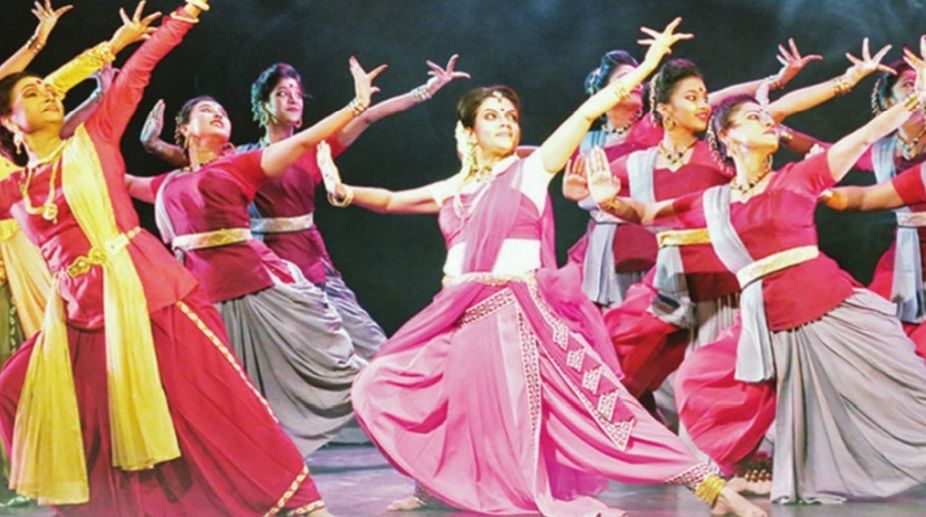Remembering Rukmini Devi
Thanks to Kathak exponent Ashimbandhu Bhattacharya and his team consisting of Avik Chaki and Subroto Pandit, rasikas got a glimpse of their excellent Kathak rendition.

I n the beginning of 2017, a three-day workshop-cum-seminar was held jointly by the West Bengal Rajya Sangeet Academy and Saraswat Sanskriti Kendra at the Academy to assess Rabindranath Tagore’s philosophy and spiritualistic ideas in the perspective of the same ideas of the country. The main speaker was Sayak Mitra who has honed his skills in the knowledge of the ancient treatise — Bharata’s Natya Sashtra — from Natya Sashtra scholar, Piyal Bhattacharya.
The event catapulted Mitra from being an upcoming aspiring scholar of the Natya Sashtra to the position of a script writer, employing the choreographic skill of Anita Mallick, Bharatanatyam performer and artistic director of Saraswat Sankriti Kendra, to launch Bhanudyuti, which created a lasting impression on the minds of rasikas. The event was held at Madhusudan Manch in Kolkata recently.
Aesthetically designed with two beautiful girls clad suitably in their dance attires sitting on either side of the stage, Bhanudyuti created an idyllic atmosphere, which foretold what was to follow. The history of Indian drama is closely knit with dance and music — and this spirit was incorporated in Bhanudyuti. The production aimed at putting spiritualism over materialism to find aesthetic bliss and eternal happiness. The story was centred on the travails of a weary traveller enacted by Prasenjit Chakraborty, who is in search of happiness. Jalsa Chanda, as the narrator, directs him to the path of salvation through the philosophy of Tagore.
Advertisement
There were sets of characters taken from the works of Tagore who made their appearances in the first scene like a tableau. The narrator presented them before the traveller to guide him to the path of salvation. There was the mother and daughter pair personifying Mother Earth and her daughter who wanted to quench the thirst of seeing the King’s son. Anita Mallick herself was in the role of the mother while Kobita Chatterjee was her daughter. They emphasised the fact that Mother Earth can give birth but cannot prevent death. She is joyless, because she has no control over the void created by time.Though aware that the mystery of creation will be revealed one day, she knows the path to it would be arduous.
The romantic rebel Rajputra and his companion from Tasher Desh (Atanu Chatterjee and Indraneel Mukhejee respectively) helped the theme to move on and clarify that material wealth cannot bring one happiness. Tired of the rigid rules of the prison palace, the prince wanted to break away to a land of free-spirit amid nature’s harvest.
Nature’s daughter, enacted by Dipan Moitra, had traversed many lives. Having got rid of her physical existence, she is evergreen and has attained salvation. She shows the way to get rid of material existence and get enlightenment. The story ends with a good question by the traveller to the narrator. Can death be peaceful, entailing no sorrow? The answer was in the affirmative. Death is the god with whom one can merge forever.
Mallick essayed her role extremely convincingly, excelling in nritta, nrityaand natya. Her rendition of Maranere tuhu mamo Shyam saman(Death you are like my Shyam) matched up to Tagore’s philosophy of the Indian ethos.
The production could be best described as a contemporary dance-theatre based on ancient Sanskrit drama using the literature of Tagore, which is quite unlike the Western theatre style. It was amazing to see dancers delivering dialogues, without any difficulty and the natyaelement was elevated with intelligence.
The group dances were spectacularly designed. Clusters of dance movements were created and executed in a fine ballet-like manner. And the body language of the dancers gave a sense of joint effort rather than solo dancing. The actors and dancers adapted themselves to come together smoothly. Dialogues and speaking portions sorted themselves out suitably, though one could make out the need for voice training in those who were only dancers. Nonetheless it was a good start and one hopes to see more such productions along the lines of Bharata’s Natya Sashtra.
As for the musical score, Suman Sarkar’s planning was superb and the voices used were amply suited for Rabindra Sangeet. With their full and sonorous voices, the singers found their way into the hearts of rasikas. One would like to make special mention of placing Tagore’s lilting lyric, Ogo ghum bhanganiya tomaye gaan sonabo as nothing else could have created a better romantic mood. In the song, Tomar khola haoay the dancers created a fitting ambience for the celebration of the free spirit of man.
Movements to the song, Aaj sakhi muhu muhu drawn from Bhanusingher Padabali; blowing of the double conch in the Manipuri Natasankirtanstyle, visually arresting dances by groups of men and women moving in a procession with vigour and vitality in a get-up-and-go fashion, waving flags, fly-whisks and playing kartals — all such elements added to the visual spectacle. One must mention that friezes proved quite an effective way of changing scenes. The journey of the weary-soul attaining enlightenment was aptly expressed in the song, Bhengeche duar esechey jyotirmoy tomari hauk joy. Bowing at the feet of the supernatural in the words of the poet, Aamar matha natho kore dao hey amar charana dhulir pore, ended the saga of the troubled soul’s intense search.
Advertisement